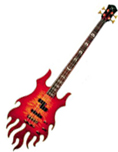Minarik Inferno 4-String Bass


AS WE ALL know, flames make cars go faster. That lesson was absorbed back in the Fifties, when custom car builders like Ed "Big Daddy" Roth began painting elegant tongues of fire across the hoods and fenders of souped-up hotrods. What you may not know, however, is that flames can also make guitars sound better. At least, that's the theory behind M.E. Minarik's flame-shaped bass, the Minarik Inferno. Having started in the guitar trade as a designer at B.C. Rich (the Goddess Warlock and India Twin guitars are among his handiwork), Minarik's fondness for outré stylings shouldn't seem surprising.
But the Inferno's extreme shape isn't simply a matter of aesthetics. Minarik has a couple of theories about guitar design, one of which holds that if you want better bass response from an instrument, you need more mass on the side where the bass strings are-hence the asymmetrical design of "tone tail" guitars, such as the Lotus, which looks kind of like a cubist rethink of the Les Paul.
Minarik's second theory, which manifests itself in the Inferno guitar and bass, has to do with "tone pockets." Not only is there increased mass on the bass-string side of these axes, the flames include hollow pockets, and are designed to boost specific frequencies and enhance the instrument's resonant complexity. Given the Inferno's shape, it's tempting to joke that it's the semi-hollowbody from hell. But the real question is: Do Minarik's theories play out, or are they just an excuse to build a wicked-looking bass?
- HEAVEN AND HELL
- Perhaps the fi rst thing to keep in mind about the Inferno is that it's a big mutha, measuring a whopping 53-1/2" from headstock to tail. Unlike most basses, the strap buttons are on the back of the body, which makes it feel less cumbersome, and although the body and 34"-scale bolt-on neck are both mahogany, it's actually much lighter than its size would suggest- no doubt another advantage of those tone pockets.
Because a good nine inches of its length is given over to tail fl ames, playing the Inferno takes a bit of getting used to. Its two-piece Tone Pros bridge sits in the center of the body, which moves the neck much further to the left (on a right-hander). That makes playing in fi rst position a bit of a stretch, especially on the G string. On the other hand, the setup naturally encourages playing by the bridge, which brings out the bite in the Inferno's tone.
This is, of course, an incredibly cool-looking bass. Turning up at a gig with one of these has roughly the same effect as turning up in a Lamborghini- people can't help but stare, and a few may drool. Our test model came with a gorgeous sunburst finish-currently the only color option- with abalone binding, a rosewood fi ngerboard with white pearl position markers, and gold hardware. It seemed loud even before I plugged it in.
When I tried it out at home, however, at first its personality seemed meeker than its looks. Because the design is supposed to enhance the instrument's bottom end, I had assumed that the sound would be big and dark, and more like the thunderous-sounding Warwick Corvette I reviewed a few months ago, for example. Instead, the Inferno's sound was round and a little trebly, more like an old Rickenbacker. After fiddling with the controls-one for the split P-Bass-style Tone Perfect neck pickup, one for the single J-Bass-style Tone Perfect bridge pickup, and one for the pickup blend-I was able to darken the tone, but even so, it was hardly the earthshaking, crater-making comet I was somehow expecting.
Playing with a band, however, the Inferno delivered as promised. It turns out that what came across as trebly in my living room actually added defi nition when there were guitars and piano crowding the upper frequencies. It was a defi nite plus when I used chorus or distortion, but otherwise didn't seem to color the sound. Instead, most of what I heard was a somewhat lean-yet balanced and forcefully strong-punchy low end. In some respects, it was more like a guitar player's notion of low end than what a bass player would imagine. So even though you wouldn't think of playing reggae with one of these fl aming beauties, the Inferno's strong low-end detail and focus would make it a great choice if you tune down a step or two, and mainly downstroke with a pick.
All the latest guitar news, interviews, lessons, reviews, deals and more, direct to your inbox!
THE BOTTOM LINE
The Minarik Inferno isn't for everyone, but hey-like a fl ame-shaped bass would be? If you think loud, act loud, and like to play loud, you'll fi nd that the Inferno is everything you'd want in a bass (and probably some of the things you'd like in a guitar). Maybe that's why its fi rst two endorsees are Gene Simmons and Lemmy Kilmister
